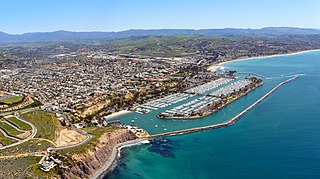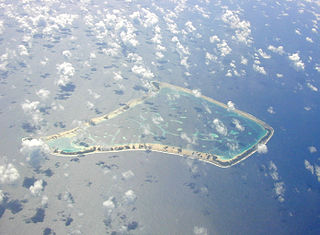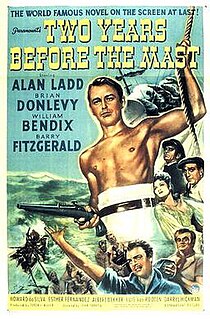Related Research Articles

The Mary Rose is a carrack-type warship of the English Tudor navy of King Henry VIII. She served for 33 years in several wars against France, Scotland, and Brittany. After being substantially rebuilt in 1536, she saw her last action on 19 July 1545. She led the attack on the galleys of a French invasion fleet, but sank in the Solent, the strait north of the Isle of Wight.

A sailing ship is a sea-going vessel that uses sails mounted on masts to harness the power of wind and propel the vessel. There is a variety of sail plans that propel sailing ships, employing square-rigged or fore-and-aft sails. Some ships carry square sails on each mast—the brig and full-rigged ship, said to be "ship-rigged" when there are three or more masts. Others carry only fore-and-aft sails on each mast, for instance some schooners. Still others employ a combination of square and fore-and-aft sails, including the barque, barquentine, and brigantine.

Dana Point is a city located in southern Orange County, California, United States. The population was 33,107 at the 2020 census. It has one of the few harbors along the Orange County coast, and with ready access via State Route 1, it is a popular local destination for surfing.

A dry dock is a narrow basin or vessel that can be flooded to allow a load to be floated in, then drained to allow that load to come to rest on a dry platform. Dry docks are used for the construction, maintenance, and repair of ships, boats, and other watercraft.

Richard Henry Dana Jr. was an American lawyer and politician from Massachusetts, a descendant of a colonial family, who gained renown as the author of the classic American memoir Two Years Before the Mast. Both as a writer and as a lawyer, he was a champion of the downtrodden, from seamen to fugitive slaves and freedmen.

Two Years Before the Mast is a memoir by the American author Richard Henry Dana Jr., published in 1840, having been written after a two-year sea voyage from Boston to California on a merchant ship starting in 1834. A film adaptation under the same name was released in 1946.

The Pilgrim was an early 19th century American sailing brig. She was immortalized by one of her sailors Richard Henry Dana Jr., who wrote the classic account Two Years Before the Mast about a 1834-1835 voyage between Massachusetts and California to trade for hides. Pilgrim caught fire and sank at sea in 1856.
This is a glossary of nautical terms; an alphabetical listing of terms and expressions connected with ships, shipping, seamanship and navigation on water, but not necessarily on the sea. Some remain current, while many date from the 17th to 19th centuries. The word nautical derives from the Latin nauticus, from Greek nautikos, from nautēs: sailor, from naus: ship.

Fakaofo, formerly known as Bowditch Island, is a South Pacific Ocean atoll located in the Tokelau Group. The actual land area is only about 3 km2, consisting of islets on a coral reef surrounding a central lagoon of some 45 km2. According to the 2006 census 483 people officially live on Fakaofo. Of those present 70% belong to the Congregational Church and 22% to the Catholic Church.

The Frogmen is a 1951 American black-and-white World War II drama film from Twentieth Century Fox, produced by Samuel G. Engel, directed by Lloyd Bacon, that stars Richard Widmark, Dana Andrews, and Gary Merrill. The film's storyline is based on operations by United States Navy Underwater Demolition Teams, popularly known as "frogmen", against the Japanese Army and naval forces. It was the first such film about scuba diving and became a popular cultural hit.

Holystone is a soft and brittle sandstone that was formerly used in the Royal Navy and US Navy for scrubbing and whitening the wooden decks of ships.

The California hide trade was a trading system of various products based in cities along the California coastline, operating from the early 1820s to the mid-1840s.

Cat and Dupli-cat is a 1967 Tom and Jerry short produced by Chuck Jones and MGM Animation/Visual Arts for Metro-Goldwyn-Mayer. It was directed by Chuck Jones and Maurice Noble, written by Jones and Michael Maltese, and animated by Dick Thompson, Ben Washam, Ken Harris, Don Towsley and Tom Ray.

Two Years Before the Mast is a 1946 adventure film based on Richard Henry Dana Jr.'s travel book of the same name. It stars Alan Ladd, Brian Donlevy, William Bendix, and Barry Fitzgerald.

The Cherokee class was a class of brig-sloops of the Royal Navy, mounting ten guns. Brig-sloops were sloops-of-war with two masts rather than the three masts of ship sloops. Orders for 115 vessels were placed, including five which were cancelled and six for which the orders were replaced by ones for equivalent steam-powered paddle vessels.
La Playa is a bayfront neighborhood in the Point Loma community of San Diego, California. It is bordered by the San Diego Bay on the east, Naval Base Point Loma on the south, the Wooded Area neighborhood to the west and Point Loma Village/Roseville-Fleetridge to the north. It lies across a channel from Shelter Island.

Deptford Dockyard was an important naval dockyard and base at Deptford on the River Thames, operated by the Royal Navy from the sixteenth to the nineteenth centuries. It built and maintained warships for 350 years, and many significant events and ships have been associated with it.
Before the 1849 California Gold Rush, American, English and Russian fur hunters were drawn to Spanish California in a California Fur Rush, to exploit its enormous fur resources. Before 1825, these Europeans were drawn to the northern and central California coast to harvest prodigious quantities of southern sea otter and fur seals, and then to the San Francisco Bay Area and Sacramento – San Joaquin River Delta to harvest beaver, river otter, marten, fisher, mink, gray fox, weasel, and harbor seal. It was California's early fur trade, more than any other single factor, that opened up the West, and the San Francisco Bay Area in particular, to world trade.

Casa de San Pedro was a hide house and one of the oldest commercial structure on the San Pedro Bay. Its site was designated a California Historic Landmark, No. 235, on June 6, 1978. The site is now near Meyler St. and Quartermaster Road in San Pedro.

José Bandini (1771–1841) was a Spanish and Mexican sea captain and early settler of San Diego, California.